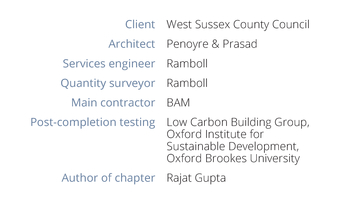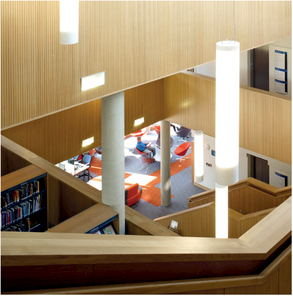CASE STUDY 4
Crawley Library
Crawley

Overview
Crawley Library is a major new civic building housing a range of county council services including a central library, register office, and administrative and social services accommodation.
The brief asked for a landmark sustainable building. Careful orientation of the building, a stepped façade and high-performance coated glass minimise solar gains, while the generous north-lit atrium floods the library with natural daylight. Efficient lighting controls with motion detection and daylight zoning maximise efficiency and reduce internal heat gains.
An assisted natural ventilation system combined with extensive thermal mass and night-time cooling is designed to provide a stable internal environment for the library and open-plan offices. The design is supplemented by renewable technologies such as a biomass boiler and a solar thermal system.


01 Internal view

02 Cross section

03 Internal view
The library building is occupied from Monday to Friday, 8am–5pm. The library areas are also open on Saturdays from 9am to 7pm. Occupancy varies significantly during the day. It is estimated that about 1,000 people visit the library on weekdays while approximately 75–100 people work in the offices.
Design approach
A core design driver was to provide the client with a long-term, loose-fit building with robust structural and environmental strategies to allow for flexible layouts and future adaptability.
Accessed off a new square, the building is arranged over three floors around a central atrium. Above the library is the council’s social services open-plan office space. The adjacent two-storey registry office has a separate entrance, also off the square. The ground-floor elevations to the public library areas are heavily glazed to showcase the facilities and welcome visitors. A café opens out on to the public square south of the building. The first-floor ceremony rooms have an external terrace that can be used for photography and outdoor gatherings. The gross internal floor area is 4,468m2, with the library taking up 2,678m2.
Environmental design
The building is designed to be energy efficient with a low heat demand. Through structured sustainability workshops with the client, options were reviewed with respect to renewables, Building Regulations Part L and wider sustainability targets. The technical targets set were:
- BREEAM Very Good and EPC ‘A’ rating
- carbon emissions 30% better than Part L 2006
- at least 20% to 30% renewable energy contribution
- an air leakage index of 5m3/h.m2 @ 50Pa
- low water usage.
The resulting building was designed with good levels of insulation, airtightness measures, high ceilings, extensive thermal mass, stratification and natural cross-ventilation and stack ventilation measures, good glazing and solar protection measures (Figure 04) and proposals on an IT procurement strategy. To ensure a low heat demand U-values were better than those specified in Part L of the Building Regulations.
A primary biomass boiler with a condensing gas boiler back-up heats the building. Hot water is provided by a solar thermal array, with central gas-fired calorifiers as back-up. A chilled-water cooling system using an air-cooled chiller serves a series of air-handling units, and fan-coil units provide primary cooling through a section of the building. The remainder of the building has an assisted natural ventilation/mixed-mode system that introduces tempered fresh air into the library spaces and open-plan office through floor plenums. In summer, windows on actuators provide additional ventilation. The plenums also provide a route for secure night-time cooling to pre-cool the building structure for the following day and prevent overheating.
A core design driver was to support flexible layouts within the library, making it possible to accommodate future change. Services and the IT network are built into library-wide raised flooring designed to loadings that allow all book stacks and furniture to be rearranged.
Good daylighting is achieved with solar-control glass shaded by cantilevered south-facing floors to control solar gains (Figures 02 and 05). The majority of the lighting was designed to operate on photometric control along with occupancy sensors in the library. A building management system (BMS) was installed to help the facilities manager run the building efficiently and monitor sub-metered energy consumption.

04 Solar studies
Monitoring and post-occupancy feedback89
The monitoring and post-occupancy evaluation of the building was undertaken as part of Innovate UK’s building performance evaluation (BPE) programme.
A review of the installed systems showed that the heating and cooling strategies did not appear to be functioning according to the initial design intent, due to inadequate commissioning and maintenance contracts. The biomass boiler had encountered breakdowns due to the low quality of biomass fuel. Maintenance provided did not address the problems effectively as the system kept failing, remaining out of operation for nearly two years. As a result, the system was perceived by the facilities-management team as unreliable and difficult to maintain. Similarly the chilled-water cooling system and the solar thermal panels were also not functioning properly, but little was done to resolve these issues. In addition to this, there was no feedback mechanism set up in the building to report the aforementioned building issues to the management.


05 South elevation: stepped façade and roof overhang help reduce solar gains
Poor maintenance and management issues are particularly evident in the case of the BMS. The system had not been optimised, and some BMS sensors had not been well calibrated. These problems resulted in the poor performance of the heating and cooling systems. After continuous efforts by the BPE team, actions were taken to address these issues, but without a maintenance contract in place many of them are likely to reappear. A review of the usability of controls revealed that controls for lights, blinds and fire alarms were intuitive and easy to use.
Despite the problems with the BMS the internal temperatures were found to fluctuate only between 20°C and 25°C in most of the rooms during much of the monitored period, indicating a robust environmental strategy able to sustain comfortable thermal conditions. Relative humidity was found to range between 25% and 60%. The highest CO2 concentrations were recorded during the winter season when the building was mechanically ventilated; however, CO2 concentration remained below 1,000ppm in all spaces.
Occupant feedback was recorded through Building User Studies (BUS) questionnaires, semi-structured interviews and walkthroughs. The survey revealed that the staff members had a positive opinion of the building, with modern design and high levels of natural light the most appreciated elements. There were, however, some negative perceptions of the ventilation, summer thermal conditions and indoor air quality, with a lack of occupant control over the windows and ventilation in the open-plan office aggravating the issue.
The BPE study revealed that despite the measured airtightness of the building fabric being 4.88m3/h.m2@ 50Pa, the thermographic survey showed air leakage around windows and cold bridges at the wall/ceiling junction in a number of rooms (Figures 06 and 07). Thermograms also revealed heating and cooling being left on in some unoccupied spaces, indicating poor control of the systems.
The energy supplied to the library was monitored for a one-year period. During this period, 157,563kWh of gas and 468,640kWh of electricity were consumed, which resulted in total emissions of 275,028kgCO2/m2/yr. The actual energy consumption was 44% more than the design estimate (9% more in gas use and 44% more in electricity use).90 The library’s annual energy consumption and the resulting carbon emissions per unit of floor area were compared to CIBSE TM46 and DEC benchmarks. In terms of gas consumption, Crawley Library performed significantly better than the benchmarks. However, the library used more electricity than both benchmarks.


06 Thermogram: heating of unoccupied spaces suggesting poor control of services


07 Thermogram: air leakage around windows and at the wall/ceiling junction


09 Internal view
A breakdown of electricity use by end user showed that 31% of electricity was used for lighting, 18% by small-power equipment, 11 % for cooling and 10% by the fans and pumps for ventilation. The library hub room, which contained a large server with its cooling system, was found to consume 9% of the total electricity and the cafe was responsible for a further 9%. Other 'unregulated' loads accounted for the remaining 12% of the total electricity.
While electricity use is more than twice the design target, a number of the increases came as a result of external factors outside design team control, namely café use (it is fitted out and run by an external operator, with actual use over six times the target), and small-power use (more than double the estimate in the target). Lighting load was 25% over the target, which could be reduced through the specification of the sensors and zoning. Overall, it should be noted that the electricity use compared to design target is not a dramatic increase relative to many other building-in-use studies.
Regular changes in facilities-management staff since handover mean that the environmental control strategy, BMS and sub-metering are not well understood by the facilities-management team, which is not able to monitor the energy performance to enable energy savings to be targeted. Lack of user guidance and understanding of the processes that take place in the building, together with minimal individual control over heating, ventilation and lighting, further undermine occupant comfort and lead to excessive energy use in the library and office spaces. As a result there is little engagement in managing the building and its performance. Going forward, in-depth training of the facilities-management team to use the BMS system, as well as proper maintenance of the biomass and solar thermal technologies, would improve control over the building systems and environmental conditions.
Conclusions
This project reveals the necessity of carefully reviewing with the client their capacity to manage the proposed technologies in the long term, and the importance of maintenance contracts, close monitoring and regular reviews of any ‘new’ technologies installed. This, alongside client-commissioned, easy-to-understand user guides and in addition to the requisite building manual, could help to ensure that users take full advantage of the design and technologies installed in the building.
Metering and sub-metering arrangements should be carefully designed and installed according to end uses and zones. It is important to ensure that sub-meters are calibrated and commissioned properly, and reconciled after handover in order to correct problems quickly and allow effective energy management.
Finally, the project illustrates how robust passive design measures and simple systems (such as the plenum ventilation system used in the library, and extensive thermal mass) are much more resilient than add-on technologies and can exceed best-practice energy targets in their own right as well as creating comfortable environments.


10 Energy and carbon graphs

11 Energy by end use graph
